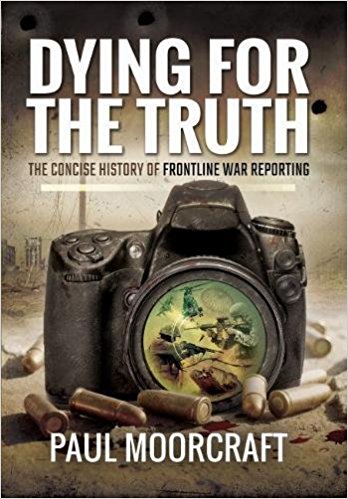Paul Moorcroft is a writer with four decades of experience in the subject matter covered in Dying for the Truth. He history has covered war reporting from the Crimean War through to today’s 24-hour TV broadcasts. The underpinning theme through this history is the conflict between the correspondents’ desire for freedom of speech (and a ‘scoop’) and the political and military demand for operational security.

Hardback 358 pp RRP: $41.00
The history lists in chronological sequence the world’s major conflicts, but also includes wars that involved a small number of belligerent nations; the Spanish Civil War, the Korean War, war in the Suez, Panama to name a few.
The First World War saw few correspondents given access to the Western Front and ‘they saw little and could report even less’. The military used writers as part of the enormously crude propaganda machine and this created a lifelong suspicion of the press. This came to haunt the British in the Second World War as the part revelation of propaganda in America during WWI made American reticent in joining the Allied cause, and a reluctance to believe in the Jewish Holocaust.
In WWII little censorship was required as journalists supported their government’s propaganda machine. While overseas listeners believed the BBC broadcasts were uncensored, the Nazis went to great lengths to stop people in occupied Europe listening to them. Ed Morrow and William Shirer, as CBS radio correspondents in London during the Blitz, provided personalized coverage of events that probably quickened American support for their involvement in the conflict. Films made on both sides of the Atlantic stirred viewers’ sympathy and also, through comedy, boosted morale.
Moorcraft summarized reporting to 1945: ‘In both World Wars correspondents had been transformed, or transformed themselves, from chained watchdog to docile lapdogs.’ He then asks: ‘After 1945 would they be able to deploy the new power of live television, and later live satellite transmissions, to break their chains?’
Many of the wars fought from 1945 until the fall of the Berlin Wall, were considered as part of the Cold War. Correspondents were mainly concerned with professional survival and few ‘made waves’ by reporting what they knew to be the unpleasant truth regarding their countries’ involvement. Quite a number of journalists have had a major impact when they resorted to publishing books on the various campaigns they had witnessed first hand.
With recent conflicts, there have been journalists embedded on ‘both sides’, so while one report shows the armament being fired, the other shows the carnage at the other end – the latter making for wonderful propaganda. Lightweight cameras used by journalists and mobile phone cameras by members of the public now make wars more difficult to hide; and perhaps spells the demise of the war correspondent we have known in the past.
Moorcraft has been most thorough in his coverage of war reporting. His style makes for easy and interesting reading. A number of ‘hacks’ such as Hemingway are mentioned, with the entire text being generously punctuated by quality battlefield photographs, portraits, maps and cartoons. There are a dozen pages of endnotes, a most comprehensive bibliography and an easy-to-navigate index.
Moorcraft’s work provides much-needed coverage of the important impact of reporting of conflicts in the past and current days. A very worthwhile addition to any collection of military history.
Reviewed for RUSIV by Neville Taylor, April 2017
Contact Royal United Services Institute about this article.






